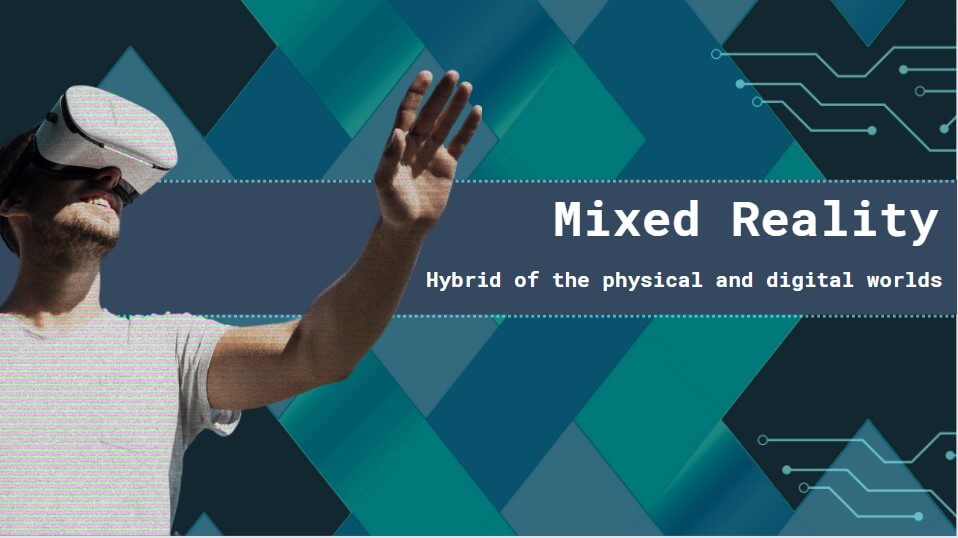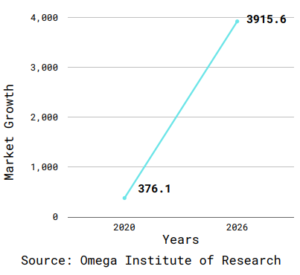- Industries
Industries
- Functions
Functions
- Insights
Insights
- Careers
Careers
- About Us
- Technology
- By Omega Team

Mixed reality is a hybrid of the physical and digital worlds that allows for natural and intuitive 3D interactions between humans, computers, and the environment. Computer vision, graphical processing, display technologies, input methods, and cloud computing have all contributed to this new reality. Consumers and businesses are increasingly adopting mixed reality. It frees us from screenbound experiences by allowing us to interact with data in our living places and with our friends instinctively. Hundreds of millions of people around the world have used their mobile devices to experience mixed reality.
Mixed Reality technology encompasses:
•Environmental understanding: The ability to map a location and superimpose information onto that location in a way that integrates virtual and real-world content.
•Human understanding: Technology that allows sensors and cameras to track human users’ motions, speech, and inputs.
•Spatial sound: 360-degree audio experiences that enhance the immersion and realism of digital experiences.History
The term mixed reality was first introduced in a 1994 by Paul Milgram and Fumio Kishino in a paper entitled “A Taxonomy of Mixed Reality Visual Displays.” The paper introduced the idea that mixed reality is a continuum that includes VR and AR, and any technology that will allow digital content to interact with real world objects.
Figure 1: Venn diagram of the aspects of mixed reality

Aspects of Virtual World
The most well-known virtual technology is the virtual reality. It’s entirely immersive, tricking your senses into believing you’re in a different place or world than the real one. You’ll enter a computer-generated world of graphics and sounds using a head-mounted display (HMD) or headset, where you can manipulate things and move about with haptic controls while linked to a console or PC. Information is superimposed on real-world items in augmented reality. One of the most well-known instances is Pokémon GO*. The real world remains central, but augmented reality enhances it with digital details, layering new layers of perception and supplementing your reality or environment. Real-world and computer elements are combined in MR. Using next-generation sensing and imaging technology, you interact with and manipulate both actual and virtual products and environments in mixed reality. Without ever removing your headset, you can view and immerse yourself in the world around you while interacting with a virtual environment with your own hands. It allows you to have one foot (or hand) in the actual world and the other in an imaginary world, breaking down basic conceptions such as “real” and “imaginary”, and providing an experience that could transform the way people play and work today.
How Mixed Reality Works
Mixed Reality is strongly reliant on the evolving human-machine relationship. An MR system must be able to understand the varied activities of a person in a certain place, as well as the surrounding landscape, in order to perform efficiently.
Mixed Reality processes data about an area using a series of cameras, sensors, and typically AI-enhanced technology, and then uses that data to generate digitally improved experiences.
When a user puts on a pair of mixed reality glasses, for example, the glasses’ cameras and sensors connect to a software program that collects as much information about the environment as possible, effectively building a virtual map of the real world. The MR technology may use that map to bring holographic images and content to the world.
Hybrid reality and extended reality are other terms for mixed reality (XR). The user’s gaze is tracked by a headset that maps the user’s real surroundings, and software utilizes deep learning techniques to align digital material with specific sections of the map.
Digital items can interact with physical objects, and humans can interact with digital objects as if they were physical, thanks to MR programming.
As a result, a standard desktop computer can be transformed into an interactive computer touch screen, or an MR-generated film character can sit on the homeowner’s couch.
Despite the fact that mixed reality is still in its infancy, it is already being employed in variety of businesses for instructional purposes. Aircraft manufacturers, for example, use MR to teach repair technicians at a low cost. Instead of removing an engine from an aircraft for training, technicians using special headsets can watch a holographic picture of an engine and interact with it using gesture, gaze, and voice user interface (VUI) instructions, changing views and extracting useful information layer by layer.
Effective working Requirements:
To work effectively, MR needs to be able to track:
- Objects surfaces and boundaries (via scene understanding and spatial mapping)
- A person’s body position and movements
- Objects and physical locations
- Ambient lighting and sound (for added realism)
Business Opportunities
- Construction – Supervisors can utilize MR to instruct workers on what tasks they need to perform. A supervisor, for example, might drop a virtual pin to indicate that a piece of equipment isn’t working properly. Workers will be notified and will use their headsets to study schematic diagrams and diagnose the problem.
- Manufacturing – During plant visits, inspectors can use MR headsets to monitor real-time data for specific mechanical components. Near Field Communication (NFC) technology can convey information regarding the component’s performance and energy consumption, and it will update when the inspector’s sight shifts to another component.
- Design – Before a product is constructed, designers can utilize MR to engage with it. For example, MR might allow spacecraft engineers to view and interact with full-scale digital prototypes of a future Mars rover to uncover potential design flaws, cutting development time and expense.
- B2B communication- International firms can utilize MR to imitate face-to-face meetings with geographically distributed product teams for B2B communication. Participants can see a live imaging size, 3-D model of the object under discussion, and translate services that can be connected to remove linguistic obstacles.
- Healthcare- Surgeons can utilize MR to practice placing a very small medical implant into the body of a specific patient. Medical students are likely to begin employing MR imaging instead of cadavers in anatomy lessons in the near future.
- Supply chain management – A supply chain manager can use his smartphone’s camera or smart glasses to observe a pallet, ask a query about the pallet’s shipping history, and get an instant response on the display.
- Training – How much time do you spend training new staff to undertake field work? What if those workers were able to learn by doing? Wearing an MR headset would provide all of the information they need for their profession right in front of their eyes. There’s no need to change context, stop what you’re doing, and look up something on the internet or in a manual. Keeping new employees focused on the job helps them to absorb the learnings in a more natural way. It’s the equivalent of always having a mentor with you to help when you need it.
- Architecture – Architects have their own design process, which starts with brainstorming, drawing, and early 3-D models. It then progresses to 3-D printing or hand-manufacturing building models, and finally to high-fidelity formats that may be given over to developers and engineers for construction. The ability to instantly examine models as if they are already built and exchange context with other MR-enabled colleagues makes MR one of the most highly awaited technologies in the architectural business.
Future Trends and Analysis:
Around 14 million workers in the US will be using smart glasses by 2025. As enterprises push for a future enhanced by extended reality, the opportunities in MR will only continue to grow. Industry experts predict that mixed reality will become a $1.2 – $6.9 billion global industry by 2024.
Figure 2: Predicted market growth by 2026

Although gaming will continue to play an important role in its development, Enterprise MR is expected to dominate mixed reality research efforts in the coming years.
Current mixed reality content is generally delivered through headsets, although holographic projections and interactive virtual displays are expected to play an important role in MR. Until recently, creating consumer products to take advantage of the MR continuum was not cost effective because the technology requires an immense amount of processing power, as well as strong computer vision and image recognition capabilities.
Big data, cloud computing and recent advances in artificial intelligence (AI) are making MR capabilities more affordable and as the price comes down, it’s expected that MR will radically change human computer interaction (HCI).
Benefits of MR
The complexity of successfully creating mixed reality experiences means we are still in the very early stages of discovering MR’s potential. However, the opportunities are potentially endless.
- Innovate faster- Generate digital twins of items and explore creative ideas more quickly. Construction and design teams can utilize mixed reality to quickly create digital twins of products and explore creative ideas with minimum waste and expenditure. With MR, you can quickly experiment with various materials and concepts.
- Collaborate- Imagine being able to collaborate on a holographic model of a new car with colleagues who are hundreds of miles apart. Mixed reality, like VR and AR, enables the creation of more immersive collaborative experiences.
- Support workers- In the spirit of collaboration, cameras on mixed reality headsets can transmit video to colleagues in real time, allowing professionals to annotate what they see (such as a machine in front of another employee) and provide real-time guidance.
- Enhance training- Extended reality has a lot of potential as a tool for training and development. Companies can use mixed reality to provide immersive training experiences for employees in a variety of settings. This not only aids in the development of muscle memory but it can also help to lessen the risk sometimes connected with certain training conditions.
- Mixed Reality can be rolled out on a huge scale- With the falling costs of virtual and augmented reality technologies and the proliferation of smartphone apps, it is now easier than ever to implement mixed reality on a wide scale.
- Mixed Reality can broaden a viewer’s horizons- Participants in a study conducted by Google agreed that the key to engaging VR is nailing the perspective. Getting the audience to think about what they’re seeing in a new way. In the end, presenting a fresh viewpoint on old and familiar issues might be more appealing than flashier and more spectacular mixed reality experiences. This is fantastic news for those working with older devices or with limited budgets.
Subscribe
Select topics and stay current with our latest insights
- Functions